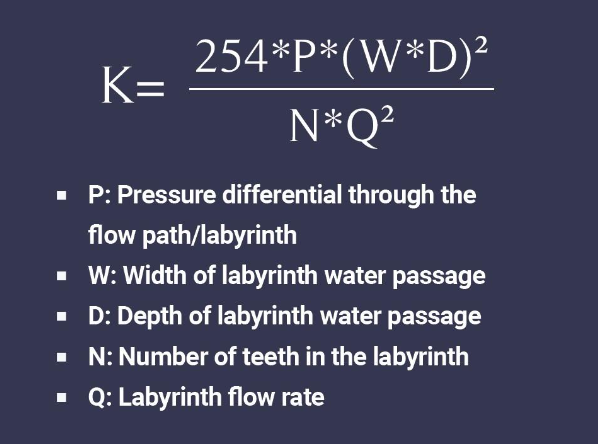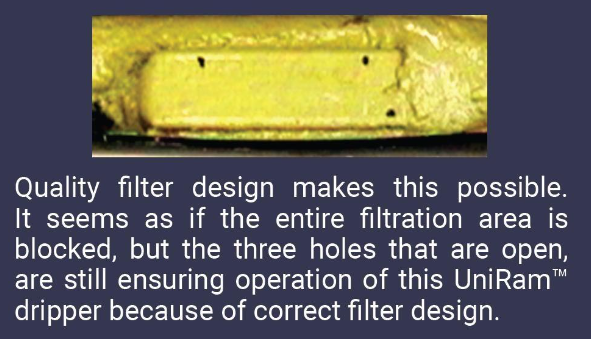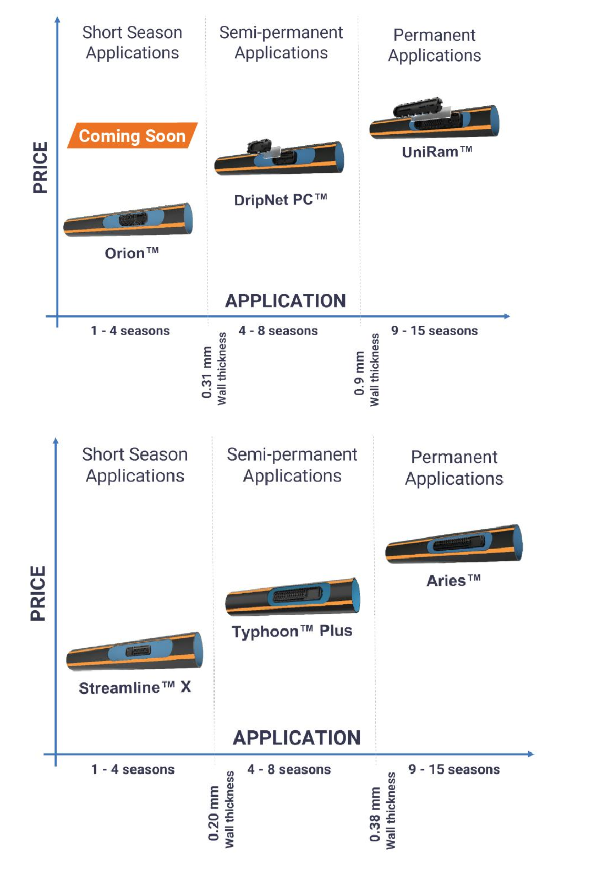Dripper Quality: A Single Source of Truth
When looking for the best hotel, you check each establishment’s star rating. When you want to choose a top restaurant, you look for the one with the most Michelin stars. Even car tyres get a speed rating based on an established framework and testing.
These rating systems allow users to judge the quality of the product or service based on a fixed standard. This improves the transfer of necessary information and highlights the value of products or services in question. Most importantly, it allows users to compare apples to apples.
Let’s talk about a rating standard for drippers: A rating that combines the vast array of features that determine how well a dripper does its job and considers every impacting factor. Such a rating will help irrigation designers and farmers choose the best dripper for every job, while balancing cost and performance.
WHAT MAKES A DRIPPER GOOD?
Jerry Austen, product manager at Netafim South Africa, explains that a good quality dripper will emit a predetermined flow rate that is accurate and constant over its intended lifetime.
“To do so, it needs to stay clean. Once a dripper is clogged, it is very difficult to return it to a state where it can again deliver a precise amount of water and nutrients to the root zone of each plant.”
A dripper’s ability to stay clean is determined by:
- Turbulence
- Filtration
THE WATER PASSAGE
The water passage, or labyrinth, is where the magic happens. According to Austen, the nature and quality of its design and manufacturing will determine the efficiency of the dripper over its lifetime.
“The greater the depth and the width of a dripper labyrinth, the better, as a wider and deeper labyrinth is more efficient for a given flow rate. The length of the dripper influences the dripper’s resistance to clogging. The longer the water passage, the more sensitive it will be to clogging as particles must pass a longer route to the outlet.”
One of the most important additions to drippers as design evolved, was the addition of teeth to the labyrinth to create turbulent flow. “This makes a massive contribution to clogging resistance as particles are kept in suspension through the turbulence created. A shorter labyrinth has fewer, more efficient teeth, and higher turbulence. The fewer teeth used to create the necessary turbulence, the better.”
He adds that the only parameter that combines the width, depth, length, and number of teeth in the labyrinth into a single score, is the turbulence coefficient (K). This is calculated by the formula below, but more importantly must be supplied by the drip manufacturer in its technical data.

Beyond these numbers, the quality of the design and manufacture of the dripper labyrinth greatly contributes to dripper quality. The better the quality of design and manufacture of the labyrinth and especially the teeth, the greater the turbulence coefficient, emphasises Austen.
TRUE FILTRATION AREA
The turbulence coefficient however does not consider the filtration area of the filter at the entrance of the dripper labyrinth. The larger the effective filtration area (EFA) of a dripper’s filter, the better its ability to stay clean, as a greater area is available for contaminants to accumulate on. It will take longer for contaminants to cover the filtration area completely.
But how do we measure the true size of the effective filtration area? Abed Masarwa, vice president of product management, Netafim, Israel, says it is a common belief that the EFA is the total area of the inlets.
“However, the size of the dripper filter is not necessarily an indication of the EFA. Another common rationale is that the effective filtration area is the area where light will shine through the dripper.”
LET’S TRY THIS METHOD WITH TWO NETAFIM DRIPPERS:

We know that UniRam™ is a larger, more advanced dripper embedded in heavy wall driplines and intended for long term use, often more than ten seasons. We also know that Streamline™ X is a smaller dripper embedded in thin wall driplines and intended for only one to three seasons’ use.
If we looked at the image, and could trust this method, our conclusion would be that Streamline™ X has a larger EFA than UniRam™ and that Streamline™ X has more protection ahead of the labyrinth than UniRam™. Based on our tested and published technical data, we however know that the UniRam™ dripper (140 mm²) has an EFA 8.75 times larger than the Streamline™ X dripper (16 mm²).
Fact is that you cannot use a shortcut to check the EFA or any other characteristic of a dripper. According to Masarwa, the only true way of evaluation and comparison is understanding and checking trusted technical data. “Dripper technical data must include an EFA (effective filtration area) value. The EFA is the area that the water passes through on its way to the dripper labyrinth. In addition to the turbulence coefficient (K), it must be included in a possible single dripper quality Score.”

RATING DRIPPER QUALITY
How can turbulence and filtration be combined into one score to rate drippers? Enter the DQ, or dripper quality score. This parameter combines the effective filtration area (EFA), measured in millimetres, with the turbulence coefficient (K).
(DQ) = EFA + K
Masarwa however explains that these two parameters cannot be logically combined by simply adding them together. “They are different types of values and do not equally contribute to dripper quality. The question is which of them is the most important and has a greater influence on the quality of the dripper. By bringing weighting into the model, human subjectivity becomes a factor, but it allows the person doing the calculations to change the weights of the EFA and K values, based on the dripper class, to see the impact thereof.”
DQ = W1*EFA+W2*K (W= Weight Factor)
WHAT MATTERS IN THE FIELD?
A successful farming endeavour is one of the most complex economic activities, as success depends on a list of factors so vast that a complete list cannot even be attempted by putting pen to paper.
Selecting the correct irrigation system is but one of the many decisions that must be made. Beyond that, finding the perfect dripper for the job, in the case of drip irrigation, can be quite a task. A massive variety of factors must be considered in dripper and dripline selection.
Austen advises that the designer and/or farmer must determine which attributes are necessary for the crop and circumstances. “A comprehensive portfolio of drippers and driplines is available that covers a wide range of crops and applications. Beyond selecting the correct dripper features, selecting the best possible quality dripper is crucial. This is where published technical data is important, and it is very important to expect this data from drip manufacturers.”
The technical aspects discussed in this article give some insight into this world of numbers and graphs.
FINDING THE BALANCE
An important goal is to maintain a balance between dripper cost and performance. Austen describes equipment cost as a sliding scale determined by a host of factors. “Consider a dripline selection graph where the vertical axis is price, and the horizontal axis is a composite of durability application, clogging resistance, and other factors considered in dripper comparison. Movement along the horizontal axis, driven by the requirements in the field, will result in movement along the vertical axis, that is an increase or decrease in price.
Take note that quality is not one of the items listed on the dripline selection graph. Whether selecting thin wall or heavy wall drip, the most advanced dripper or dripper with fewer features, quality cannot be compromised on. “Although it might not seem so, it is possible not to veer from selecting quality products, while still maintaining the optimal balance between drip irrigation performance and your budgetary restrictions,” says Austen.
“Consider the necessary specifications to truly determine which dripline can be relied on in the field. Look for a product that offers guaranteed longevity and is designed and manufactured with the explicit goal to decrease clogging risk and deliver water uniformly and efficiently.”
Dripline selection boils down to selecting the correct product for the crop and circumstances, selecting a quality product that can do the job at hand in difficult conditions and selecting the product that will offer the best return on investment on the other hand.
A wide range of drippers and driplines are available for different applications. See the graphs below. Click here to see our dripline offer here.



Share your thoughts
Comments
We'd love to hear your thoughts! To enter a comment, type your name and email address.